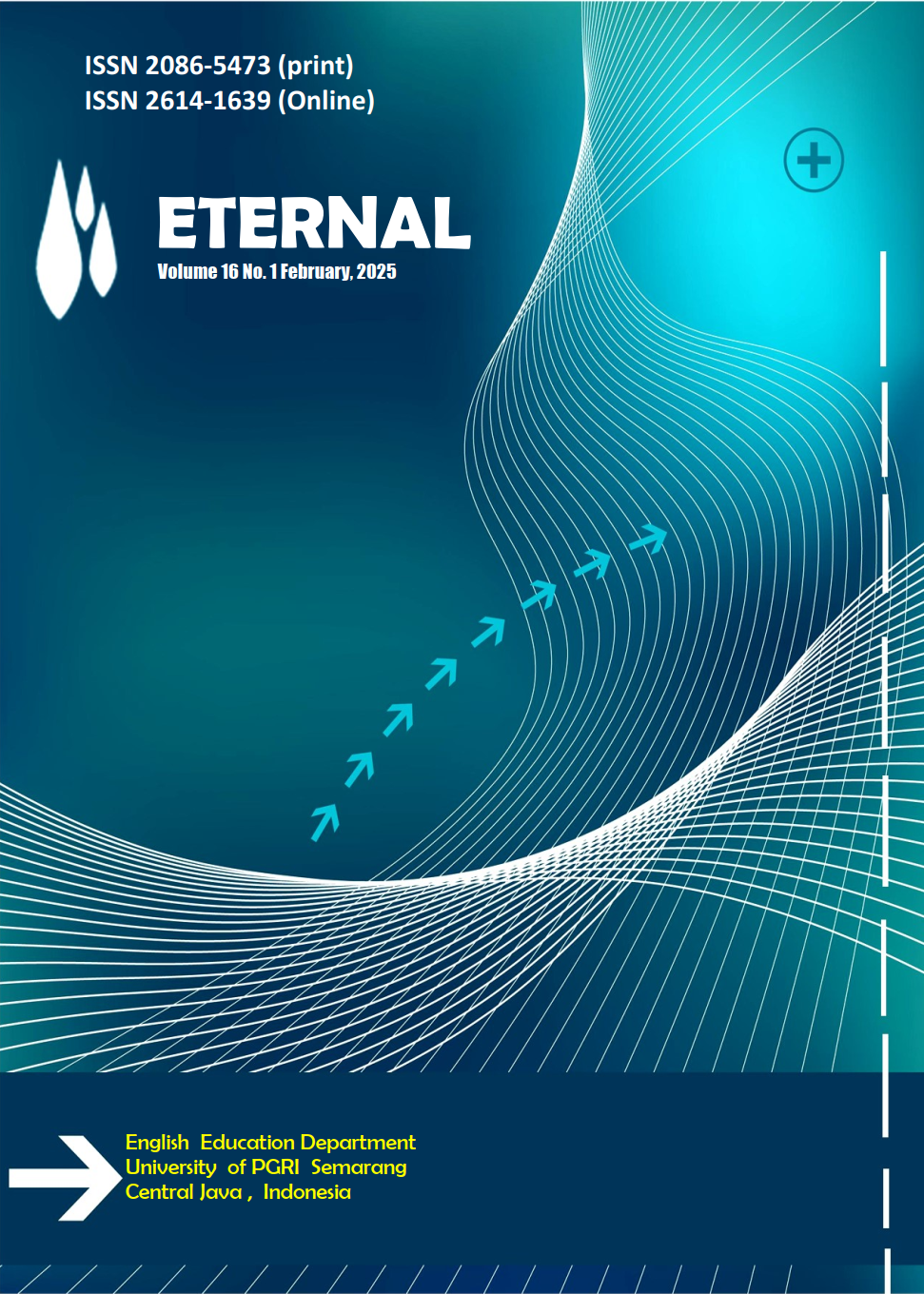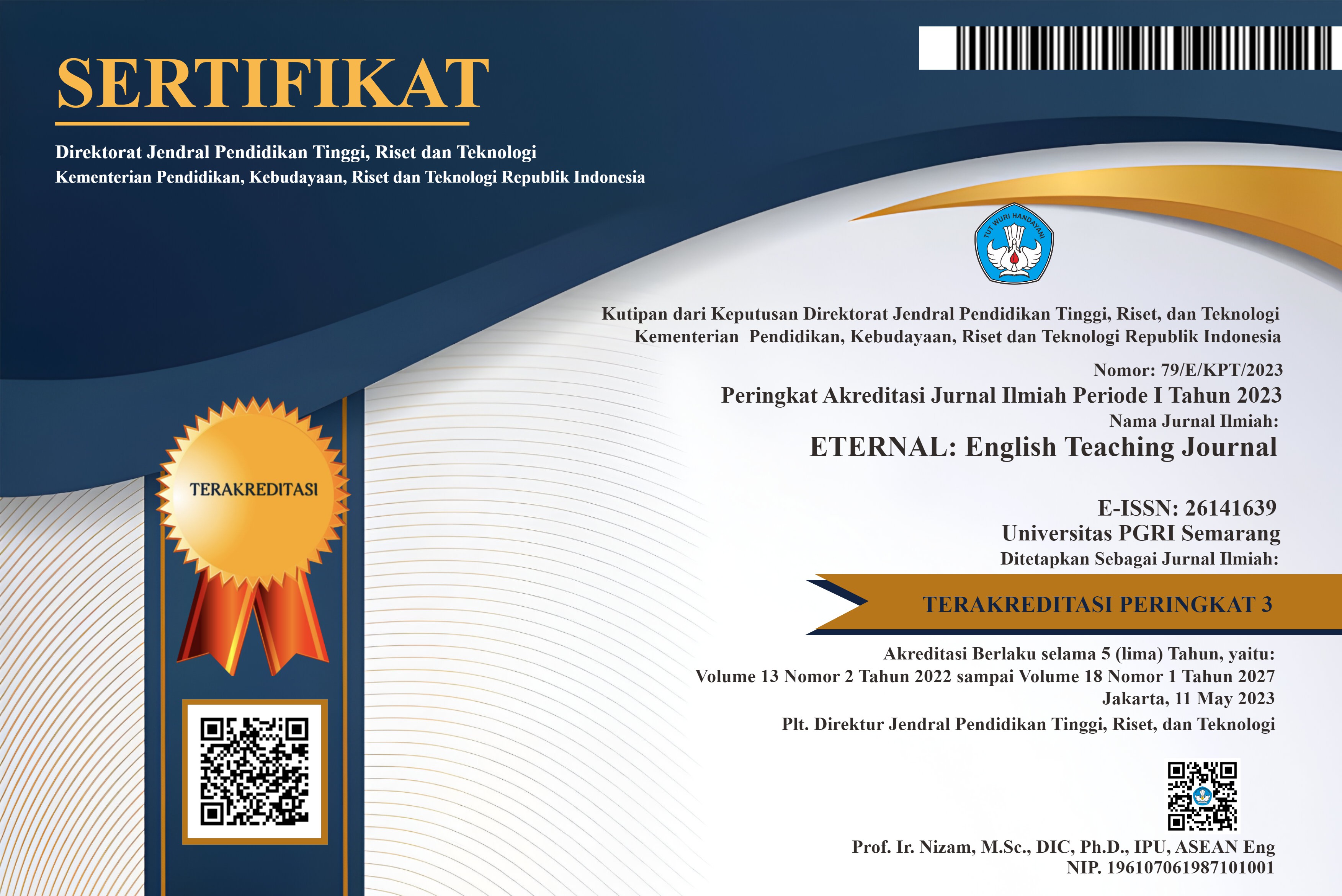Principles of Developing “V-I-S-U-A-L-S” Media in Teaching English to Young Learners at SD GMIT Oepura
DOI:
https://doi.org/10.26877/eternal.v16i2.1602Keywords:
Principles of developing V-I-S-U-A-L-S media, teaching English for young learnersAbstract
Abstract. This research aims to help EYL teachers utilize the media to achieve learning goals. The learning process becomes fun, students are pro-active in learning, the material is easy to understand and there is interaction between teachers and students. The research was conducted in the SD GMIT Oepura, where the researcher taught the elementary students using EYL media which EYL students have made. This focuses on how the elementary students respond to the media itself whether the media interacted with them or not. The research data was collected through observation. Analysis was carried out through analytical descriptive methods and qualitative content analysis. Research on this topic is about V-I-S-U-A-L-S which stands for visible, interesting, simple, useful, accurate, legitimate, and structured, was obtained from (1.) Media create a memorable learning experience, understand complex and abstract concepts through colorful images, grab attention, and encourage active participation. (2.) Psychologically, the v-i-s-u-a-l-s media development provides meaningful experiences, and builds the young learners’ creativity by overcoming limitations of time, space, and energy that make the learning more interactive, improving the quality of their learning outcomes. (3.) V-i-s-u-a-l-s media helps students understand difficult material, making the learning process more interesting and varied, and making students more active in class. (4.) V-i-s-u-a-l-s media builds students’ creativity to develop their interaction easily between teachers and students so that learning activities are more effective and efficient. (5.) V-i-s-u-a-l-s media stimulated young learners to learn more actively. (6.) V-i-s-u-a-l-s media helps the teaching and learning process with various benefits, such as reducing obstacles in the learning process, assisting teachers in providing explanations of learning material, helping students absorb lesson material more deeply, helping students think concretely, and helping students build creativity.
References
Alberta Education. Early Learning Branch. (2009) Working with young children who are learning English as a new language. Alberta: Early Learning Branch.
Baker, F, (2015). Learning Styles in Children.
http://www.kidspot.com.au/school/primary/learning-and-behaviour/learning-styles-in children/newsstory/2c188e7d8ca8d273b2f441fcae6ae1ba
Cameron. L. (2001). Teaching english to young learners. Cambridge University Press. Linse
Cameron,L, (2002). Teaching languages to young learners. UK: Cambridge University Press
Chau, C. (2001). Infant learning 9-12 months. http://www.leapfrog.com/en-us/learning-path/articles/learning-through-year-one. LeapFrog Enterprises,Inc.All rights reserved
Chamot, A.U. (1993). Student responses to learning strategy instruction in the foreign language classroom. Foreign language annals, 26, 308-321
Dale, Edgar. (1969). Audio Visual Methods in Teaching, New York: Holt, Rinehart and Winston Inc. The Dryden Press.
Degeng, I Nyoman Sudana. (1993) Media Pendidikan. Malang: FIP IKIP Malang.
Dewi, P. (2019). Teaching English for young learners through ICTs. Humanitatis: Journal of Language and Literature, 6(1), 11-24.
Hamalik, O. (1994). Media Pendidikan, cetakan ke-7. Bandung: Penerbit PT. Citra Aditya Bakti.
Hambandima, E.S.N. (2021) Pengembangan sebuah Pengajaran Responsif Budaya (Crt) pada Kelas Drama (sebuah Kolaborasi Mahasiwa dalam Pementasan Drama Cerita Lokal). Jurnal Perspektif Ilmu Pendidikan, 35(2), pp.160-166.
Heinrich. R, Michael. M & James D. R. (1982) Instructional Media and the New Technology of Instruction, New York: Jonh Wily and Sons.
Kristiana.V & Nurmala. D. (2019) Pelatihan Teknik ‘Word Match GAMES”
Dalam Penajaran Kosakata Bahasa Inggris di Sekolah Dasar. Prosiding Seminar Nasional Hasil Pengabdian 2019
Linse, C.T. (2005). Young Learners. USA:McGraw Hill.
Mukminan, (2008) Pengembangan Media Pembelajaran. Universitas Negeri Yogyakarta. 34 Membuat Media Pembelajaran yang Menarik
O’Malley,J.M & Chamot, A.U. (1990). Learning Strategies in Second Language Acquisition. UK: Cambridge
Prayatni, I. (2019). Teaching English to young learners. Jurnal Ilmiah Profesi Pendidikan, 4(2), 106-110.
Puspitarini, Y. D., & Hanif, M. (2019). Using Learning Media to Increase Learning Motivation in Elementary School. Anatolian Journal of Education, 4(2), 53-60.
Putra, J. R. (2012). Creating a positive English language teaching and learning environment in EYL classroom setting. Proceeding Teflin 2.
Rozie, F. (2018). Persepsi guru sekolah dasar tentang penggunaan media pembelajaran sebagai alat bantu pencapaian tujuan pembelajaran. Widyagogik: Jurnal Pendidikan dan Pembelajaran Sekolah Dasar, 5(2), 99.
Tejo, N. S, N. & Rivai, A. (1992). Media Pengajaran. Bandung: Penerbit CV. Sinar Baru Bandung.
Trini, P., & Prasetya,I.(2001). Media sederhana.Jakarta: PAU-PPAI.
Willar,B,M (2022). The Instructional Media to Teach English for Young Learner. JELTEC: Journal of English Language Teaching, Literature and Culture E-ISSN: 2963-3842, 1-13







